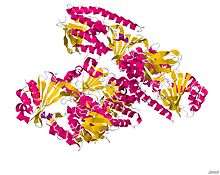Monooxygenase
Monooxygenases are enzymes that incorporate one hydroxyl group into substrates in many metabolic pathways. In this reaction, the two atoms of dioxygen are reduced to one hydroxyl group and one H2O molecule by the concomitant oxidation of NAD(P)H.[2][3] One important subset of the monooxygenases, the cytochrome P450 omega hydroxylases, is used by cells to metabolize arachidonic acid (i.e. eicosatetraenoic acid) to the cell signaling molecules, 20-hydroxyeicosatetraenoic acid or to reduce or totally inactivate the activate signaling molecules for example by hydroxylating leukotriene B4 to 20-hydroxy-leukotriene B5, 5-hydroxyeicosatetraenoic acid to 5,20-dihydroxyeicosatetraenoic acid, 5-oxo-eicosatetraenoic acid to 5-oxo-20-hydroxyeicosatetraenoic acid, 12-hydroxyeicosatetraenoic acid to 12,20-dihydroxyeicosatetraenoic acid, and epoxyeicosatrienoic acids to 20-hydroxy-epoxyeicosatrienoic acids.
| Monooxygenase | |||||||||
|---|---|---|---|---|---|---|---|---|---|
 Structure of the TetX monooxygenase in complex with the substrate 7-Iodtetracycline.[1] | |||||||||
| Identifiers | |||||||||
| Symbol | FAD_binding_3 | ||||||||
| Pfam | PF01494 | ||||||||
| InterPro | IPR002938 | ||||||||
| SCOPe | 2phh / SUPFAM | ||||||||
| |||||||||
Classification
They are classified as oxidoreductase enzymes that catalyzes an electron transfer.
Human proteins containing this domain
COQ6; CYP450; MICAL1; MICAL2; MICAL2PV1; MICAL2PV2; MICAL3;
See also
References
- PDB: 2Y6Q; Volkers G, Palm GJ, Weiss MS, Wright GD, Hinrichs W (April 2011). "Structural basis for a new tetracycline resistance mechanism relying on the TetX monooxygenase". FEBS Lett. 585 (7): 1061–6. doi:10.1016/j.febslet.2011.03.012. PMID 21402075.
- Harayama S, Kok M, Neidle EL (1992). "Functional and evolutionary relationships among diverse oxygenases". Annu. Rev. Microbiol. 46: 565–601. doi:10.1146/annurev.mi.46.100192.003025. PMID 1444267.
- Schreuder HA, van Berkel WJ, Eppink MH, Bunthol C (1999). "Phe161 and Arg166 variants of p-hydroxybenzoate hydroxylase. Implications for NADPH recognition and structural stability". FEBS Lett. 443 (3): 251–255. doi:10.1016/S0014-5793(98)01726-8. PMID 10025942.
External links
